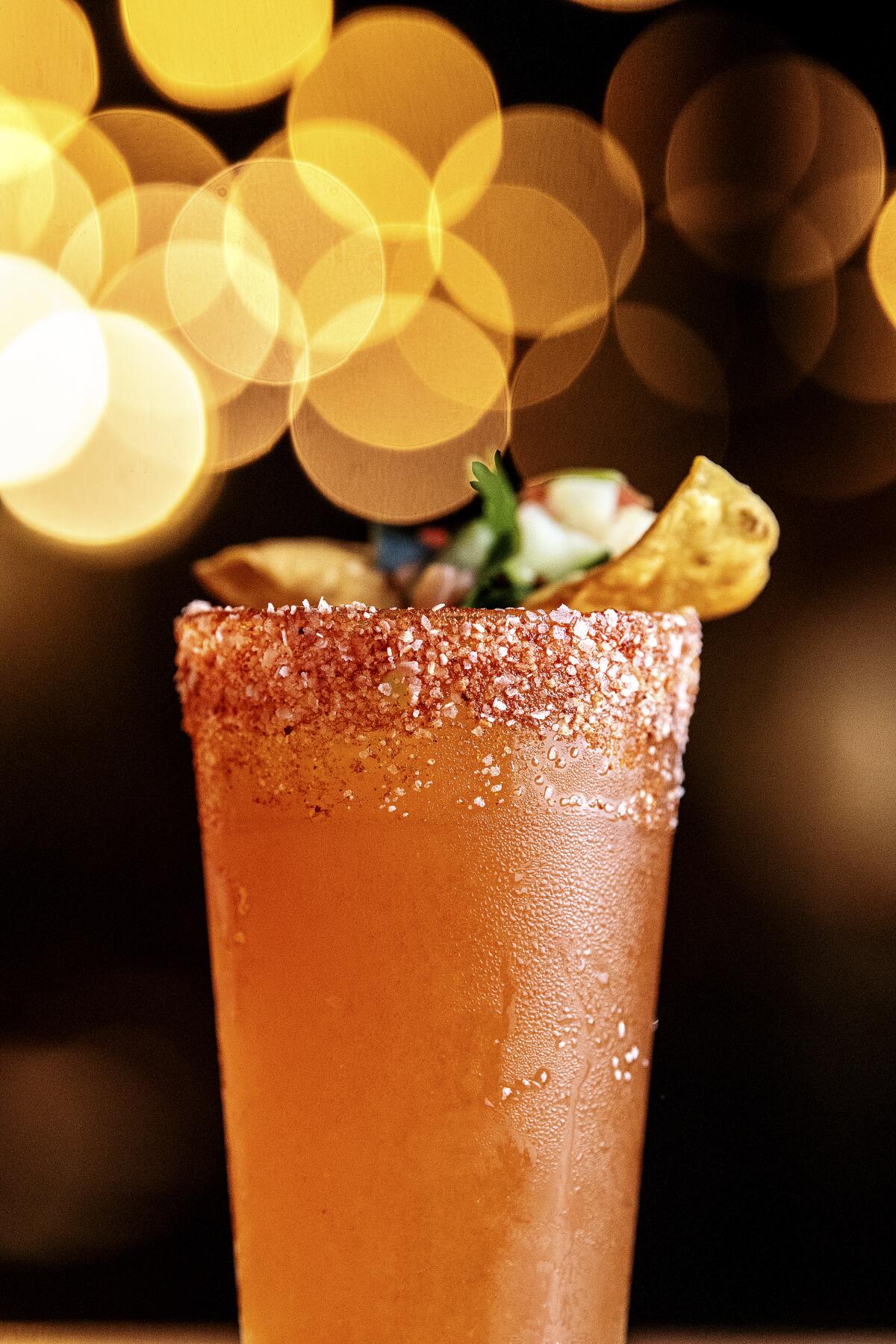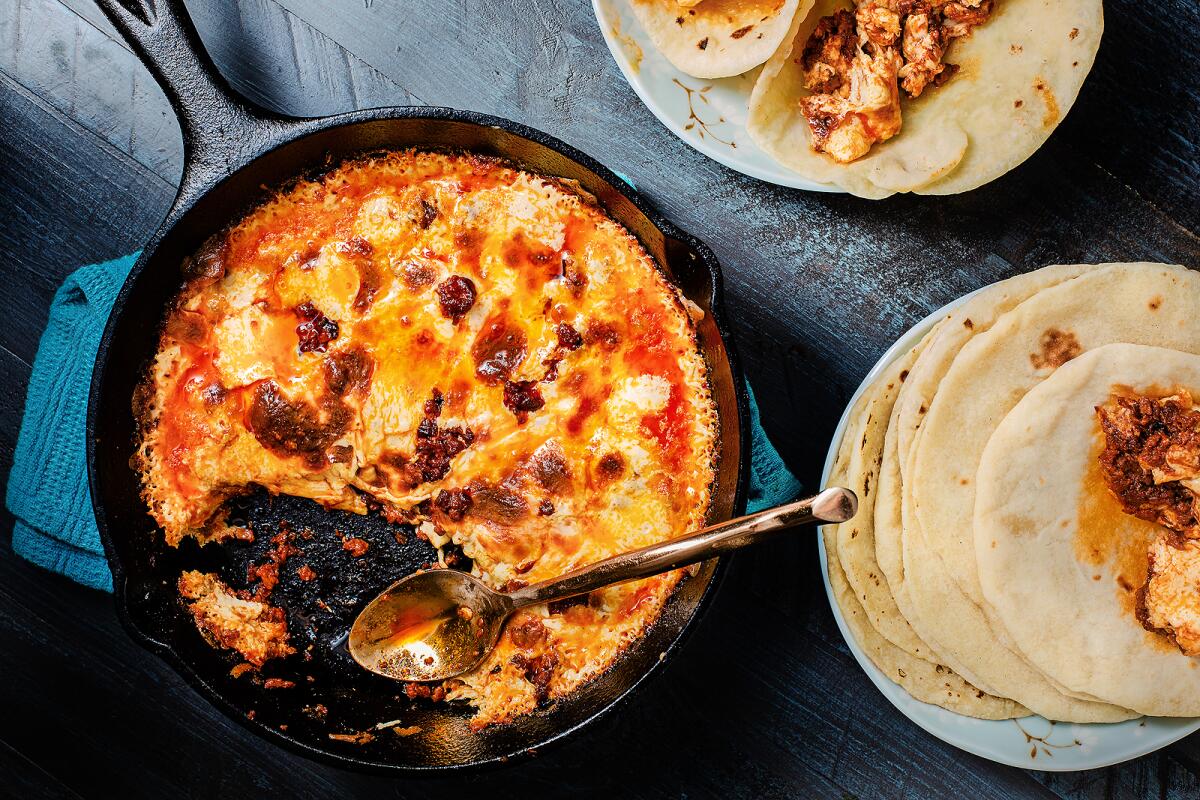The Cinco de Mayo recipes you need for micheladas, guacamole and queso fundido

- Share via
You are reading our Cooking newsletter
Sign up to get a taste of Los Angeles — and the world — in your own home and in your inbox every Friday
You may occasionally receive promotional content from the Los Angeles Times.
The fact that Americans celebrate Cinco de Mayo as if it’s the most Mexican of holidays is a bit like if Mexicans were to take on George Washington’s birthday with burger-eating, whiskey-slinging, red-white-and-blue gusto. Cinco de Mayo, the fifth of May, celebrates Mexico’s victory in the Battle of Puebla, in which the lesser-equipped Mexican forces resisted the French under Emperor Napoleon III. As exciting as the victory might have been in the moment, a year later, the French succeeded in capturing Puebla (a city about 85 miles southeast of the nation’s capital), and the year after that, they captured Mexico City and installed Austrian Ferdinand Maximilian in his three-year, not-too-sweet and relatively unknown reign as Emperor of Mexico.
Still, a win is a win. And the victory had other historical significance. Some say it may have helped prevent Napoleon from lending his hand to the Confederacy in the Civil War. President Lincoln opposed foreign occupation of Mexico; he threw his support behind exiled president Benito Juarez, and in 1867, two years after the Civil War ended, Juarez ordered Maximilian to be executed by firing squad — and the Mexican Republic was restored.
Still, Cinco de Mayo is not even a bank holiday in Mexico, and yet it’s the biggest Mexican holiday celebrated here. How did Cinco de Mayo come to be so important in the U.S.? I called Mexico City native Jimmy Shaw, owner of Lotería Grill, and a former marketing executive with a wealth of knowledge about the history and culture of his homeland. Shaw said that this relatively low-key Mexican holiday became Cinco de Mayo as we know it — the day Americans party hard with a Mexican theme — in the 1980s, gracias, not surprisingly, to marketing. Beer and liquor companies seized on this day, which falls roughly three weeks before Memorial Day, the unofficial start of the summer season, as a way to get a head start on summer festivities — and thus, sell more alcohol.
A holiday invented as an excuse to make summer longer? Ok!
Thinking about what to eat and cook and serve for Cinco de Mayo, I imagined myself singing “Cielito Lindo” in a Mexico City cantina. What would they serve? What would I want to eat and drink?
First things being first, I would order a michelada, which at its simplest is a beer with lime juice (not like a wedge, but like a lot of lime juice) and a salted rim (escarchado, or “frosted” in Mexico) — like a beer margarita. A chelada is the same thing, with Clamato, Tabasco and Worcestershire added — think beer Bloody Mary. (These words can mean the opposite depending on what part of Mexico you’re in. Look! Here former L.A. Times cooking editor Genevieve Ko refers to what I call a chelada as michelada. It’s all just loco! To be sure to get what I want when I’m ordering, I specify that I want the one with just beer, salt and lime, and sometimes, because I’m media gringa, I ask for ice.) These days, like everything else in the food and drink world, all bets around what makes a michelada or a chelada are off, as L.A. Times Food editor Daniel Hernandez explores here.
If you’re more of a margarita person, there are plenty of options and I won’t fault you for that. But in my fictional cantina, you’d more likely see people sipping tequila with sangrita (a spicy tomato-based drink served alongside tequila), or mezcal, with a plate of orange slices and sal de gusano, or worm salt.
Of course, guacamole comes next, and this year, thanks again to Hernandez, we have the official definition of Mexico City-style guacamole: no tomatoes, no onion. (I’m in full agreement on the tomatoes and it’s about time someone set the record straight. But I insist on onion, because that’s the way my Mexican grandmother did it. Need I say more?)
To take your guacamole situation to the next level, make your own totopos, or chips. (It’s easier than you think and once you dip a warm, salted chip in your guac, you’ll have a hard time going back to store-bought.)
To each his own salsa, but I love a salsa molcajete, so named because it’s traditionally made by grinding the salsa ingredients (charred tomato, onion and chiles) in a molcajete. You can grind the ingredients in a food processor, but the charring and hand-mashing is half the fun. (The other half, of course, is eating it.)
Queso fundido, a small casuela or cast-iron skillet of melted cheese, often topped with crumbled Mexican chorizo and served with corn tortillas, is a great way to soak up beer – and to tell the French, who needs you, fondue!? The deep, caramelized flavors of spicy salsa macha would be my first choice on that molten cheese, but it’s molten cheese. Seriously. How can you go wrong? Since Americans have adopted Cinco de Mayo as their own, it’s fitting to celebrate with a very American adaptation of Mexican flavors: Nachos, anyone? If you don’t feel like cooking, at Lotería, they’re offering a free order of nachos or taquitos with any online or call-in catering menu order – only on the fifth of May.
Here’s to celebrating independence the world over, and freedom from oppressors of all kinds!
Eating out this week? Sign up for Tasting Notes to get our restaurant experts’ insights and off-the-cuff takes on where they’re dining right now.
Michelada
These days, michelada can refer to an almost endless variety of beer cocktails. I still like the classic: an ice-cold glass with a salted rim, a lot of lime juice and a beer. On a hot day, I add ice. Look for Mexican limes, which are the same as Key limes. They’re small, yellow-ish and much juicier than the big, green, often juiceless limes you see in grocery stores. You can find Mexican limes at hispanic grocery stores and in conventional grocery stores; look for Key limes sold in meshed bags from Melissa’s Produce. Make your michelada with whatever cerveza you like!
Get the recipe.
Serves 1.

Sangrita
I don’t know about you, but I always find the ROI (return on the investment) of making margaritas at home disappointing. Instead, I suggest you invest in a good bottle of tequila — or a selection of tequilas — and make sangrita, a spicy, tomato-y, Bloody Mary-like beverage typically served in a shot glass alongside a glass of tequila. The experience is bound to be a conversation piece, especially three tequilas in. (I would skip the sweet and sour mix in this recipe.)
Get the recipe.
Makes about 4 ½ cups.
Enjoying this newsletter?
Consider becoming a Times subscriber.
Mexico City-Style Spicy Guacamole
Guacamole translates to “avocado sauce” in Nahuatl, and the best guacamole, like this one, courtesy of our Food editor and resident Mexico City expert Daniel Hernandez, is all about the avocado. Added ingredients, such as chile, lime and salt, are there to enhance the flavor of the avocado, not distract from it. Somewhere along the way here in gringolandia, guacamole has gotten lost in translation and all kinds of crazy things – from garlic powder to cumin, and raw tomatoes – have been added. It’s time to get back to basics; make guacamole about the avocado again.
Get the recipe.
Cooking time: 30 minutes. Serves 2 to 4.

Queso Fundido
Mexican fondue, or queso fundido, is the best fondue. It’s often topped with crumbled Mexican chorizo (spicy sausage) and served with tortillas (you could use flour or corn) and salsa. What you put on top of the melted queso is entirely up to you, and I urge you to get creative because we are independent and free! At the popular restaurant Nico’s in Mexico City, I once had queso fundido topped with a small mountain of ethereally crisp fried parsley leaves. I’ve never seen it before or since — not even at Nico’s. I guess I’ll have to make it myself. If you shop at a Mexican market, you can swap out the cheeses in this recipe for more traditional Asadero, Mennonite, Manchego or Chihuahua.
Get the recipe.
Cooking time: 45 minutes. Serves 12.

Have a cooking question?
Eat your way across L.A.
Get our weekly Tasting Notes newsletter for reviews, news and more.
You may occasionally receive promotional content from the Los Angeles Times.



